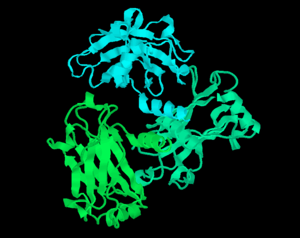RasMol
 RasMol ribbon diagram rendering of TRAF2 trimer PDB:1DOA | |
| Original author(s) | Roger A. Sayle |
|---|---|
| Developer(s) | Herbert J. Bernstein |
| Initial release | 1992 |
| Stable release |
2.7.5.1
/ July 17, 2009 |
| Repository |
|
| Written in | C |
| Operating system | Unix, Windows |
| Platform | IA-32, x86-64 |
| Available in | English |
| Type | Molecular graphics |
| License | GPL |
| Website |
www |
RasMol is a computer program written for molecular graphics visualization intended and used mainly to depict and explore biological macromolecule structures, such as those found in the Protein Data Bank. It was originally developed by Roger Sayle in the early 1990s.[1]
Historically, it was an important tool for molecular biologists since the extremely optimized program allowed the software to run on (then) modestly powerful personal computers. Before RasMol, visualization software ran on graphics workstations that, due to their cost, were less accessible to scholars. RasMol continues to be important for research in structural biology, and has become important in education.
RasMol has a complex licensing version history. Starting with the version 2.7 series,[2] RasMol source code is dual-licensed under a GNU General Public License (GPL), or custom license RASLIC.[3] Starting with version 2.7.5, a GPL is the only license valid for binary distributions.
RasMol includes a scripting language, to perform many functions such as selecting certain protein chains, changing colors, etc. Jmol and Sirius software have incorporated this language into their commands.
Protein Data Bank (PDB) files can be downloaded for visualization from members of the Worldwide Protein Data Bank (wwPDB). These have been uploaded by researchers who have characterized the structure of molecules usually by X-ray crystallography, protein NMR spectroscopy, or cryo-electron microscopy.
Interprocess communication
Rasmol can communicate with other programs via Tcl/Tk on Unix platforms, and via Dynamic Data Exchange (DDE) on Microsoft Windows.
With a multiple sequence alignment program, the responsible Java class can be freely used in other applications.[4]
See also
References
- ↑ Roger Sayle and E. James Milner-White. "RasMol: Biomolecular graphics for all", Trends in Biochemical Sciences (TIBS), September 1995, Vol. 20, No. 9, p. 374
- ↑ Herbert J. Bernstein, "Recent changes to RasMol, recombining the variants, Trends in Biochemical Sciences (TIBS), September 2000, Vol. 25, No. 9, pp. 453-455
- ↑ RASLIC license
- ↑ Multiple alignment program
External links
| Wikimedia Commons has media related to RasMol. |
- Official website
- Download RasMol (production releases)
- Source repository (stable)
- Source repository (development)
- Protein databanks and files
- RasMol development history